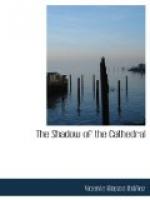The only books that were produced in those times were written by the prelates of Toledo. They compiled the laws, they anointed the heads of the monarchs with the holy oil, they set up Wamba as king, they conspired against the life of Egica, and the councils assembled in the basilica of Santa Leocadia were political assemblies in which the mitre was on the throne and the crown of the king at the feet of the prelate.
At the coming of the Saracen invasion the series of persecuted prelates begins again. They did not now fear for their lives as during the time of Roman intolerance; for Mussulmen as a rule do not martyr, and furthermore, they respect the beliefs of the conquered.
All the churches in Toledo remained in the hands of the Christian Muzarabes[1] with the exception of the Cathedral, which was converted into the principal mosque.
[Footnote 1: Muzarabes—Christians living among the Moors and mixing with them; also an ancient form of service still continued in one chapel in Toledo and in one at Salamanca.]
The Catholic bishops were respected by the Moors, as were also the Hebrew rabbis; but the Church was poor, and the continual wars between the Saracens and the Christians, together with the reprisals which set a seal on the barbarities of the reconquest, made the continuance and life of worship extremely difficult.
Having arrived at this point Gabriel read the obscure names of Cixila, Elipando and Wistremiro. Saint Eulogio termed this last “the torch of the Holy Spirit, and the light of Spain”; but history is silent as to his deeds, and Saint Eulogio was martyred and killed by the Moors in Cordova on account of his excessive religious zeal. Benito, a Frenchman who succeeded to the chair, not to be behind his predecessors, made the Virgin send him down another chasuble to a church in his own country before he came to Toledo.
After these, came the interesting chronology of the warrior archbishops, warriors of coat-of-mail and two-edged sword, the conquerors who, leaving the choir to the meek and humble, mounted their war-horses and thought they were not serving God unless during the year they added sundry towns and pasture lands to the goods of the Church. They arrived in the eleventh century, with Alfonso VI., to the conquest of Toledo. The first were French monks from the famous Abbey of Cluny, sent by the Abbot Hugo to the convent of




